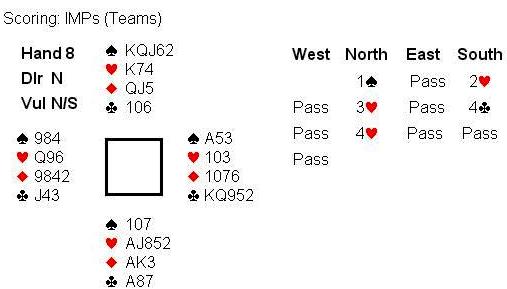By Larry Matheny for www.northerncoloradobridge.com
One of the most common mistakes made at the bridge table is the failure to stop and process the available information. Good habits must be developed both as a defender and as declarer. Here are some example hands to demonstrate.
Sometimes the simplest play can be overlooked. Here is a hand where an extra overtrick was missed.

West led a low heart won by declarer with the ten. Declarer played the ace and queen of diamonds to make sure that suit behaved and counted 10 tricks: 3 spades, 1 heart, 4 diamonds and 2 club tricks. Without enough thought, declarer played two more diamonds and then took the losing club finesse. West won the queen and exited with a club to wait for two more heart tricks.
With the nine of hearts in dummy, declarer missed an easy play for this eleventh trick. He should just concede his king and jack of hearts and the nine becomes the second overtrick. This simple play was missed by over half of the N/S pairs in one of our local games.
Far too often bridge players don’t consider the form of scoring when planning their line of play or defense. In this example, one of the declarers put a possible overtrick ahead of ensuring the safety of his game contract.
Scoring: IMPs (Teams)

West led a low club won by declarer with the ace. Declarer didn’t give this hand much thought because he saw only 3 losers: 1 spade, 1 club, and assuming the hearts behaved, only 1 trump trick. He led a second club and won the diamond shift with the ace. Next he ruffed his last club followed by the king of hearts and a low heart to the jack. West won the queen and shifted to the nine of spades. East won and put a fourth round of clubs on the table the suddenly West’s nine of hearts had been promoted to a winner. Declarer struggled but finally admitted defeat.
At the other table in this team game, declarer didn’t take any chances. After ruffing the third club in dummy, he led a heart to the ace followed by another to dummy’s king. He only lost the 3 obvious tricks and made his game. The +100 and +620 meant a 12 IMP swing.

North-South reached a grand slam in hearts and West led a trump. Declarer saw he did indeed have 13 tricks: 1 spade, 1 spade ruff, 5 hearts, 5 diamonds, and 1 club. He quickly won the ace of spades, ruffed a spade in dummy, and drew trumps in three rounds. He then led the FOUR of diamond to dummy blocking the suit. He squirmed a bit but finally had to concede a club. His partner sighed and made a quick glance at the partnership desk.
Playing too quickly struck again. After counting his tricks, declarer should have looked around for possible problems and the potential blocking of the diamond suit could have been spotted. Obviously, declarer has no trouble if he plays his ten, nine, and eight of diamonds under dummy’s three honors.
These example hands provided the following lessons:
1. Don’t play to trick one until you have considered all of the information available.
2. Play the hand, not the suit.
3. Remember the form of scoring.
4. Consider the auction when declaring or defending.
5. Count! Count! Count!
6. Stop and Think!
